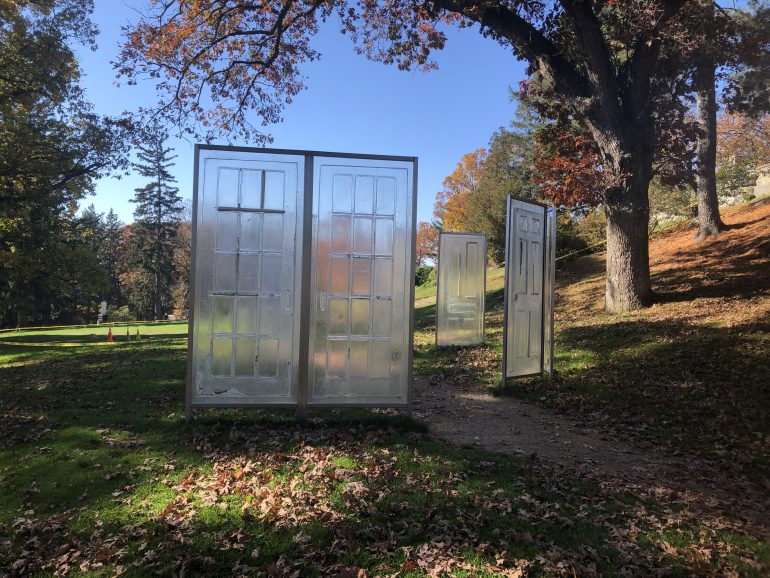In 2022, just as ChatGPT became widely available, Stephen Marché declared in a much-quoted article that “The College Essay is Dead”[1] .
Marché’s clickbait title concealed a deeper call to re-evaluate the humanities and social sciences in a tech-centred future. And he also predicted that we would be slow – perhaps even fatally late – to the task:
Going by my experience as a former Shakespeare professor, I figure it will take 10 years for academia to face this new reality: two years for the students to figure out the tech, three more years for the professors to recognize that students are using the tech, and then five years for university administrators to decide what, if anything, to do about it.
Marché, 2022
But Marché’s timeline has not proven to be accurate. Within the institutional contexts that I find myself (as a current Shakespeare scholar at The University of Sydney) we have responded far more quickly.
For me, the advent of large language models has prompted me to think more closely than I had before about how and why I ask students to write. Over the last year, initially funded by a VC Strategic Education Grant, I have led a project involving colleagues from the Faculty of Arts and Social Sciences (FASS), and also worked closely with the Schools of Business and Law.
In workshops with teachers and with students, across multiple teaching days and group discussions, we have explored what values we collectively associate with student writing and how these might be nurtured by emerging practices of teaching and assessment.
Our focus has been on the “open assessment” side of USYD’s distinction between assured and open assessments. Specifically, we have been thinking about the possible futures of the open “writing assignment”. A renewed affection for in-person exams has been one response from some unit coordinators. But turning to the invigilated exam risks missing opportunities to develop innovative open assessments where students are supported to learn over time, and that don’t turn good teachers into “bad cops”. Open assessments allow us to help students develop – as well as test – their knowledge, skills, and critical thinking
Two widely-shared ideas emerged from our conversations. Seemingly basic, they remain important places to start:
- Process over product. Critical thinking is iterative, cultivated through reflection. Final pieces of work are never as important as what happens along the way. This understanding affects how we communicate our values – independence, attention to method, reflective practices – through instructions, rubrics, and grades.
- Time matters. Generative AI can condense the traditional essay timeline; all of its tasks (idea-generation; drafting; editing) can be accomplished in an instant. We need to find purposeful ways to build time back into our students’ work patterns, designing tutorials and assessments that foster the agency of each student.
John Warner offers three frameworks for “how to think about writing in the age of AI” in his 2025 book, More Than Words. Under the term, “resist”, Warner highlights the need to preserve and even nurture human autonomy in our relationship with AI. For “renew”, he prompts us re-think our existing teaching in the light of AI’s ubiquity. Warner had already lamented the tired, generic, and dutiful student writing that some of us were seeing before ChatGPT arrived (Warner, 2018). Now we have the motive and opportunity to develop something more authentic and creative. Finally, with “explore”, Warner suggests that “we have some duty, both collectively and individually, to explore [AI’s] potential and its pitfalls.”
Each of these on its own would not be enough to meet current challenges. Together, they provide a framework for maintaining essential values and integrating them into our teaching.
Below, I illustrate how my FASS colleagues are skilfully employing all three.
Explore: Encouraging Meta-Discussions About AI
Many colleagues describe using AI to teach more equitably in a diverse student classroom. Introducing an AI agent at an appropriate stage of the student writing assignment can level the playing field for students with varied backgrounds. In FRNC 2200 (French and Francophone Literatures I), Clara Sitbon noticed that her students, well-trained in French language, did not necessarily have the conceptual tools to discuss literary texts. She used Cogniti to build an agent that helps students test their understandings of key concepts as they prepare their first literary analyses in French. This is especially valuable for students who are doing textual analysis for the first time.
Clara’s example includes student agency about whether to use Cogniti, as well as an opportunity for students to detail how and why they used the agent. This meta-discussion of AI has become commonplace across many units. Students are often asked to say something about process, helping us, as educators, to understand how they access information and apply it. At its best, this kind of practice is discipline-specific, built into the learning environments of the unit.
In PRFM 1601 (Making Theatre: Beyond Drama), Glen McGillivray takes an opportunity to develop his students’ critical AI literacy in preparation for a major essay that asks them to apply performance theories to a text – a challenging assessment in his first-year unit. In two tutorials, students use generative AI to brainstorm ideas, which they then test and discuss with tutors and peers. Glen observes that this approach helps students apply theory whilst cultivating awareness of the affordances and limits of the technology.
Resist: Minimising Convenience and Desire
In the Sydney Assessment Framework, the use of generative AI tools may not be prohibited or restricted for open assessments, such as those featured in this Strategic Education Grant project. (Future Teaching@Sydney articles will highlight secure writing assessments, or those that offer assurance of learning through in-class assessments such as interactive orals.) However, many FASS educators are thinking intentionally about the core skills they want students to develop, and how to disincentivise the use of AI when it might undermine those goals.
In GCST 2603 (Human / Animal Cultures), Thom Van Dooren articulates two pieces of writing across a number of learning situations, from a visit to the Chau Chak Wing Museum to a class presentation and a final piece of writing.[2] The first creative writing piece engages with an animal object of the student’s choosing, and this is followed up by a peer discussion linking it to cultural theories. Thom notes that this approach “provides a structured learning opportunity that deepens throughout the semester and encourages greater engagement from students. […] to make generative AI less convenient and less desirable.”
Renew: Making Steps Count
We can no longer simply set essay questions and send students away with them, confident that their work (on library shelves; in scholarly databases) will develop an independent understanding. Instead, many of us are building the processes of reading, researching and writing more authentically into the classroom. Drawing on ideas of process writing from the discipline of writing studies or even on the writing workshops common to creative writing, these approaches reintroduce slowness and intentionality, ensuring students are actively engaged with each step.
In ENGL 3713 (Shakespeare), I have developed a writing assignment that includes in-class writing and a “curve ball” experience. Students start to analyse a passage of their own choice in one class, but must then incorporate new material from a different play, given to them blind, the following week. Each of these steps is recorded over the course of several weeks, ending with an “un-conclusion” that reflects on insights and possible future directions for their next piece of work.
This assessment supports students’ analytical skills and their handling of complex textual evidence, whilst platforming writing as an iterative process that requires self-reflection. Further accountability is built into the activity through discussions and group writing sessions.
Un-Conclusion
The writing strategies referenced below all foreground our two insights: Process and Time. Often, they deliberately slow our students down at strategic moments, purposefully producing a little breathing space across the unit of study, moments where critical understanding is built and not just tested.
Some strategies incorporate targeted uses of AI; others discourage it where appropriate. Crucially, they all help students find their own voice within their disciplines, even as they navigate a world saturated by AI.
Following my own lead, what insights do I draw and what will I bring into my future practice? I have learned a lot from people working in cognate and sometimes quite disparate disciplines; translating their work into my own field has engaged my teaching design brain in ways that have been exciting and productive. I have also come to love talking directly with students about what I value in their work. If our teaching strategies support and reward innovation, diversity, and idiosyncrasy, then students learn that their voices matter.
Continue the Conversation
Want to explore this further? Join Associate Professor Huw Griffiths for a practical seminar on navigating student writing in the GenAI era.
Essays in the Era of LLMs
Thursday 9 October 2025, 1:00 – 2:00 PM
Register here
Whether you’re worried about AI’s impact on student writing or simply curious about practical strategies, this seminar offers concrete approaches for any educator who uses written assessments. You’ll discover practical strategies alongside key insights into possible futures for student writing.
Part of the AI and Assessment series – exploring transferable, practical approaches to assessment in the age of generative AI.
Appendix: detailed assessments
This appendix provides unit-by-unit details of assessment structures, tasks, and purposes for the units discussed in this article to support clarity and comparison.
Click the ➕ beside each unit title to expand and view the full details.
➕
FRNC2200: French and Francophone Literatures
➕
PRFM1601: Making Theatre: Beyond Drama
➕
GCST2603: Animal / Human Cultures
➕
ENGL3713: Shakespeare
Footnotes
[1] One of the examples used later in this piece was provided by my colleague, Associate Professor Glen McGillivray. As colleagues may know, Glen died unexpectedly on 11 August this year. Glen had been a great interlocutor on this project and his example, simple and direct as it is, stands as some small evidence of what I know from experience was his constant and strong commitment to challenging and supporting his students at every step. He will be missed. I miss him. Thanks also go to Professor Mary Wright for her expert editorial eye on this piece; to Sathsara Radaliyagoda for her work in administering and sustaining multiple conversations across my Faculty; to the many FASS colleagues and students spoken to along the way, all of them wanting to get this right; and to colleagues also from other Faculties. This last year, I’ve had many conversations with people I might not ordinarily have met and learned a great deal. But special thanks go out to Dr Carmen Vallis (Business), Associate Professor Kevin Walton (Law), and Associate Professor Charles Fairchild (Conservatorium) for their participation in a brief but productive working party earlier this year.
[2] Thom’s assessment design draws closely on his collaboration with Julia Kindt (Classics and Ancient History), a collaboration that produced “A Curious Trail of Animal Tails” at the Chau Chak Wing Museum.





